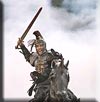
King Arthur is linked to Scotland in a number of locations. The battles with the Picts would have been the main reason for him to have been in Scotland with an army
Arthurs Seat Arthur's Seat is a huge crag that towers above the city of Edinburgh. It has been known as Arthur's Seat since the fifteenth century. It is probably named after a local hero who happened to bear the name Arthur, rather than any connection with King Arthur.
Camelon Some believe that real King Arthur was a Scottish leader named Artorius. Artorius' Camelot is supposed to have been Roman fort on the Antoinine wall. This fortress was known as Camelon, and hence they say, Camelot
Drumelzier Drumelzier is a small town in the Borders area of Scotland. In the King Arthur legend associated with Drumelzier, Merlin is portrayed as a wild prophet of the woods, and the grave of Merlin is here..
Dumbarton Rock Dumbarton Rock is in the town of Dumbarton, west of Glasgow. It was a stronghold in the 5th and 6th centuries, the time of Arthur. Excavation has revealed that earthwork ramparts defended the site, and shards of Mediterranean amphorae pottery have been found. Any association with King Arthur is less certain.
Loch Arthur Loch Arthur is the most northern of the putative Excalibur lakes. The last resting place of the sword of King Arthur.
Loch Lomand Loch Lomond is a large lake about twenty miles northwest of Glasgow. Geoffrey of Monmouth tells of an offensive by King Arthur against the Picts and Scots at Loch Lomand.
Meigle Meigle is in mid-Scotland north of Perth. Local legend has it that Queen Guinevere made her way to Scotland after the death of King Arthur and died here.
Mote of Mark The Mote of Mark is a hill in south Dumfries and Galloway. This fort was occupied from the 5th to 7th centuries which is during the King Arthur time frame. But it is only the name and the date of use as a fort that makes any King Arthur connection.
Stirling The Stirling Round Table, also known as the King's Knot, is in a field below the castle, in land that was once a royal garden. There are references from the 15th century to King Arthur keeping the Round Table in Stirling.
